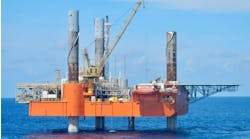Offshore staff
HAMILTON, Bermuda - Seadrill has agreed with Saudi Aramco to reduce its dayrate for four jackups over a period of one year.
The rigs concerned are theWest Callisto and the three Asia Offshore Drilling-owned jackups AOD I, AOD II, and AOD III.
Seadrill has a three-year firm contract from Aramco for the AOD rigs that is due to expire next year, although there is an option to extend until 2017.
During 1Q, Seadrill signed one new contract, with a duration of a year, with Coastal Energy for the jackupWest Cressida, with potential revenue of $35 million
Currently the contractor has 15 rigs under construction, comprising four drillships, three semis and eight jackups. Total remaining yard instalments for these newbuilds are around $4.3 billion, with $1.1 billion already paid to the yards in pre-delivery instalments
Seadrill says the downturn in the offshore drilling market has continued so far this year and signs point to demand remaining significantly lower than in 2014.
The outlook for ultra-deepwater activity beyond 2015 is difficult to judge, it adds, with most oil companies not looking to add rig capacity at this point. Capacity utilization will likely dip further as the year progresses, leading to a significant number of ultra-deepwater rigs being stacked by the end of the year.
Currently the global order book for new ultra-deepwater rigs totals 89 units, of which 29 are Sete newbuilds. At the same time, however, around 70 units are coming off contracts, many of which are due for a 15 or 20- year classing between now and the end of 2017.
Over the longer term, Seadrill says it is difficult to picture a market that does not require deep and ultra-deepwater production to satisfy world hydrocarbon demand. During the current downturn, however, rig owners will likely continue to focus on cost-saving measures and operational performance will be a must as oil companies seek to renegotiate or cancel contracts.
Turning to the premium jackup sector, the contractor saysshelf production remains an attractive, cost- effective source of production for oil companies.
Following the drop in dayrates, there may be increased activity in the near term for short-term contracts. However, an excess supply situation is emerging, with roughly 50 jackups set to enter service this year and 100 between now and 2017. As a result, pricing is likely to come under continued pressure.
Operators will continue to focus their activity on the most capable units, with stacking and scrapping of older jackups accelerating. There are currently around 240 units in the global fleet that are over 30 years old, and some will probably be retired if the downturn continues, Seadrill says.
5/28/2015


